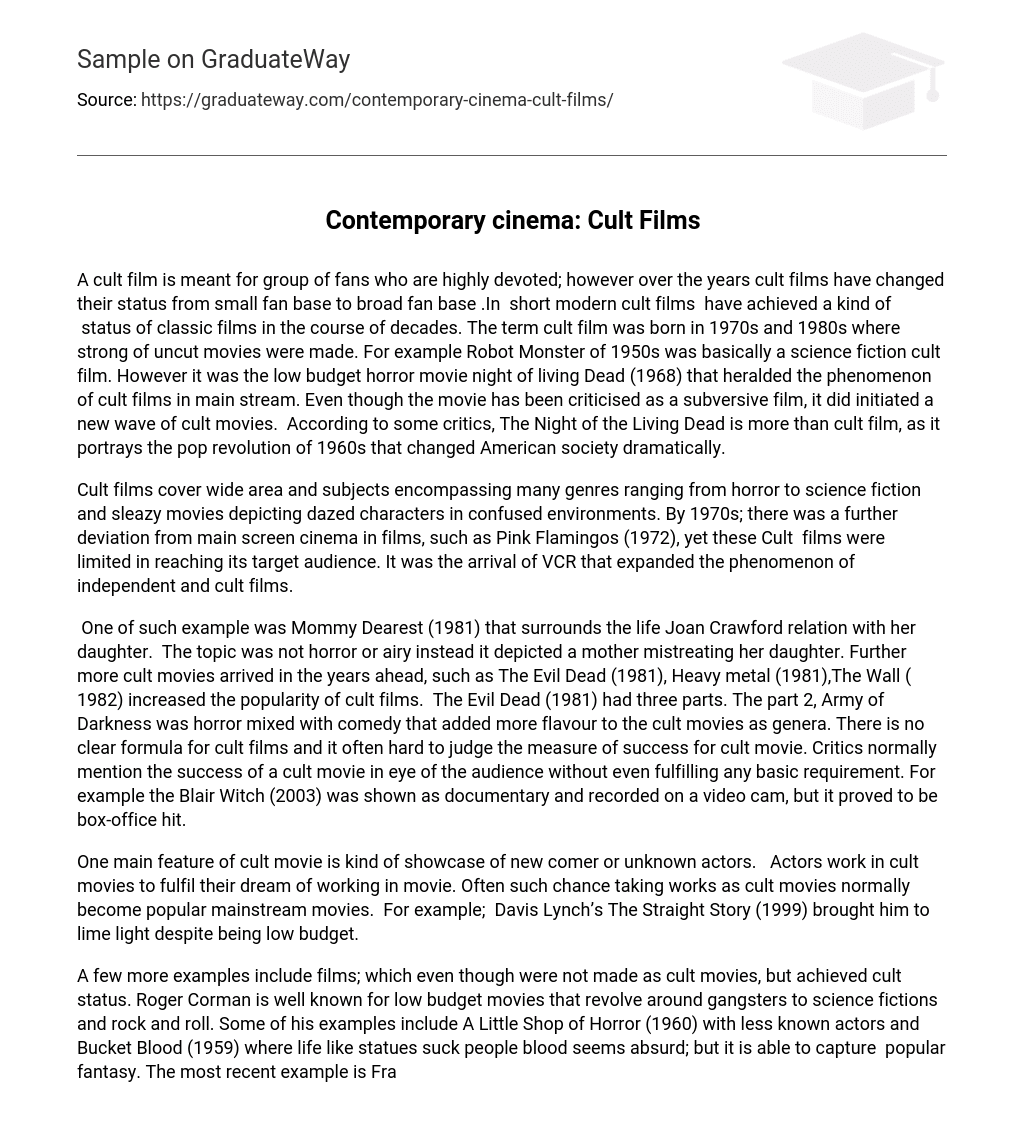A cult film is meant for group of fans who are highly devoted; however over the years cult films have changed their status from small fan base to broad fan base .In short modern cult films have achieved a kind of status of classic films in the course of decades. The term cult film was born in 1970s and 1980s where strong of uncut movies were made. For example Robot Monster of 1950s was basically a science fiction cult film. However it was the low budget horror movie night of living Dead (1968) that heralded the phenomenon of cult films in main stream. Even though the movie has been criticised as a subversive film, it did initiated a new wave of cult movies. According to some critics, The Night of the Living Dead is more than cult film, as it portrays the pop revolution of 1960s that changed American society dramatically.
Cult films cover wide area and subjects encompassing many genres ranging from horror to science fiction and sleazy movies depicting dazed characters in confused environments. By 1970s; there was a further deviation from main screen cinema in films, such as Pink Flamingos (1972), yet these Cult films were limited in reaching its target audience. It was the arrival of VCR that expanded the phenomenon of independent and cult films.
One of such example was Mommy Dearest (1981) that surrounds the life Joan Crawford relation with her daughter. The topic was not horror or airy instead it depicted a mother mistreating her daughter. Further more cult movies arrived in the years ahead, such as The Evil Dead (1981), Heavy metal (1981),The Wall ( 1982) increased the popularity of cult films. The Evil Dead (1981) had three parts. The part 2, Army of Darkness was horror mixed with comedy that added more flavour to the cult movies as genera. There is no clear formula for cult films and it often hard to judge the measure of success for cult movie. Critics normally mention the success of a cult movie in eye of the audience without even fulfilling any basic requirement. For example the Blair Witch (2003) was shown as documentary and recorded on a video cam, but it proved to be box-office hit.
One main feature of cult movie is kind of showcase of new comer or unknown actors. Actors work in cult movies to fulfil their dream of working in movie. Often such chance taking works as cult movies normally become popular mainstream movies. For example; Davis Lynch’s The Straight Story (1999) brought him to lime light despite being low budget.
A few more examples include films; which even though were not made as cult movies, but achieved cult status. Roger Corman is well known for low budget movies that revolve around gangsters to science fictions and rock and roll. Some of his examples include A Little Shop of Horror (1960) with less known actors and Bucket Blood (1959) where life like statues suck people blood seems absurd; but it is able to capture popular fantasy. The most recent example is Frankenstein unbound (1990) as usual low budget movie based on hypes and popular myths.
All cult movies are not horror movies, instead some of these movies, such as Wizard of OZ is old movie, but it has become a classic due to its unique and universal appeal. There are other kind of cult movies; where diverse topics, such as homosexuality are discussed. The similar can be said about Star Trek series; even though it come under science fiction genre; however its designation as cult movies is its fan base; which worship it like cult .
Thus we can conclude that cult films started in the cinema as bizarre or unusual films, but over the decades, it has evolved into more mature genera encompassing various topics and areas providing wish- fulfilment for cinema goers worldwide.
Reference
- Linda Badley, (1993). Film, Horror, and the Body Fantastic . Greenwood Press.
- Steffen Hantke, (2004). Horror Film: Creating and Marketing Fear . University Press of Mississippi.
- Cult Films, CULT FILMS. Retrieved December 12, 2007.





